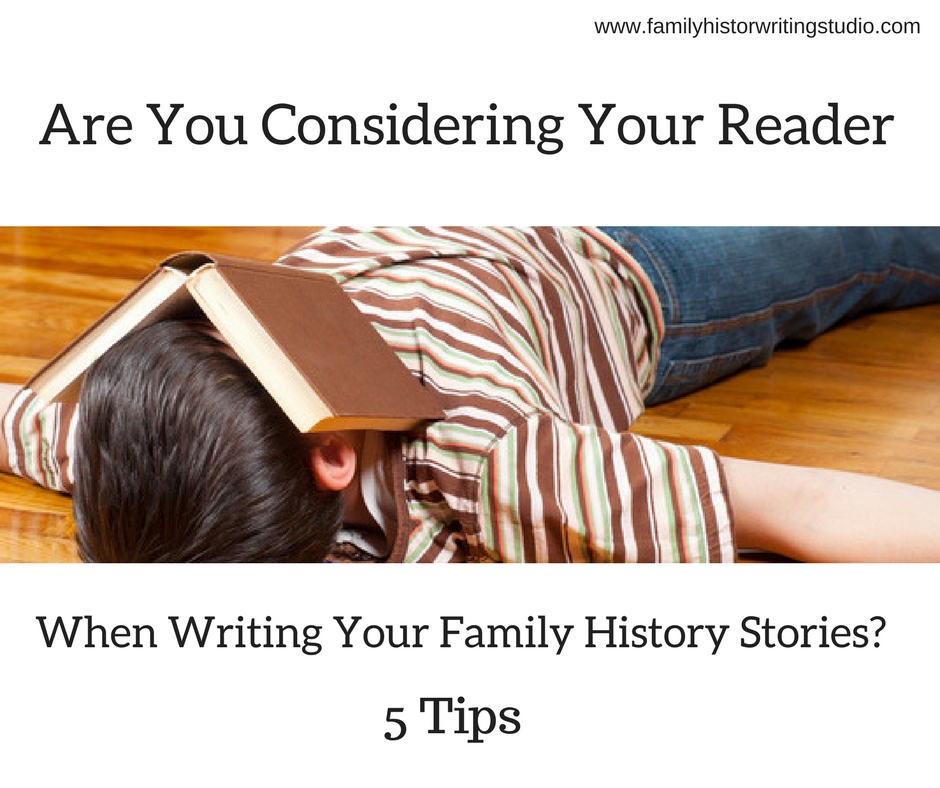I’ve heard it preached many times, write for yourself. While this is a lovely thought, it can be very misleading advice. While it is important for you to be emotionally invested in your story, it is unrealistic to only write for yourself, especially if your goal is to get your family to read your ancestor’s stories. You can’t write your family history stories without considering your audience.
You want your stories read after all isn’t that the point of writing them. Therefore, when you choose your subject, how to structure the story and what you include in the story it must all come back to your reader. Will your choices encourage your family to read your stories?
Today, I’ve got five writing tips that demonstrate why you always need to consider your readers when writing your family history stories.
Tip 1. Focus the story on the struggles of one ancestor
Don’t make your story too broad including a lot of ancestors and covering a lifetime of events. The more you focus your narrative on one ancestor and a specific accomplishment in your ancestor’s life the more likely your readers will connect with that ancestor. Concentrate your story on one ancestor and zero in on the struggles that one ancestor faced in his or her life. When you concentrate your story in this manner, you give your reader an opportunity to connect with that ancestor. When the reader connects, the story gets read.
Tip 2. Show the risk involved if your ancestor failed to overcome his struggles.
Think about the choices your ancestor made. What would have happened if your ancestor had made a different decision? What if your ancestor had chosen a different path? What kind of devastation would they have encountered? How would their life have changed? How would your life had been different? When you reveal the risks that your ancestor faced in their lives and convey that in your story, you create tension. Tension is a critical ingredient in any story to keeping the reader engaged. For instance, let’s speculate what risks were involved if your an ancestor hadn’t immigrated? Perhaps, your ancestor would have ended up in the poorhouse, or fighting in the war or remained poor with no opportunities for improving their financial or societal status. Maybe your ancestor would have died in a war or from disease? When you reveal the alternatives, you increase the tension for your readers and make your stories far more appealing. Your readers are likely to stay committed to the end of the story because they want to read how their ancestors succeeded.
Tip 3. Structure your story to show rising tension
When you take the time to arrange your story in such a way that it increases the tension, then you keep your reader tuned in. Often, family historians fall into the pattern of writing a birth to death story about their ancestor. Don’t fall into this trap. Instead, structure the story around a significant accomplishment that your ancestor achieved. In your story, show how your ancestor overcame obstacles to reach this achievement. This will create what we call rising tension. Structuring a story with increasing tension will keep your readers interested and turning the pages.
Tip 4. Keep it short and add pictures
We live in the days of immediacy. We want everything fast. The same can be said for reading your family history. Give your readers quick easily digestible and shareable stories. Today’s generation isn’t interested in a 500-page family history. Write short stories about a variety of ancestors to draw in your reader and keep them engaged. Don’t discount what your family likes to read, and how they want to read. What will it take to get them interested? It might mean writing a blog post or short story instead of an epic novel or a dry genealogy. You must be willing to adjust accordingly. Keep it short and throw in a few pictures and you’re more likely to attract them into reading your story.
Tip 5. Keep the content relevant and relatable
The more you can help your readers relate to their ancestors the more likely they are to connect with them and take a further interest in their family history. Keep the content relevant to the times but also try to show how your ancestor’s lives might parallel your readers’ lives today. Consider how your reader can see themselves in your ancestor. How will they relate to them? The more relatable and likeable the ancestor the more engaged the reader.
You can’t dismiss your reader’s likes and needs when it comes to reading their family history stories. When you take the time to learn and write family history stories that entertain and engage your reader you are more likely to find your readers taking a more in-depth interest. If you would like your family to read your family history stories, then you need to keep them top of mind when you write.
Let’s create stories that give you the greatest chance of having them read and enjoyed by your readers.

